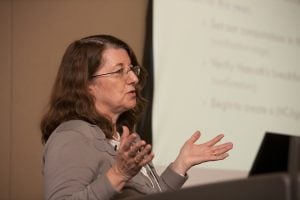
Paulette Clancy joined ChemBE as Department Head and professor Aug. 1. A specialist in computational materials science, she comes to Johns Hopkins from Cornell University, where she served as the Samuel W. and M. Diane Bodman Professor of Chemical and Biomolecular Engineering Emerita and the inaugural director of the Cornell Institute for Computational Science and Engineering.
“I want the department to make an impact socially and environmentally,” Clancy says. “We can help make this a better world; if engineers are not doing that, who is going to? I want this department to contribute to what it means to be human in the 21st century.”
A native of London, England, Clancy graduated with First Class Honors from London University and received a D. Phil in physical chemistry from Oxford University. She did post-doctoral research at Cornell and at London University, and joined the faculty at Cornell in 1987. She served two terms as the William C. Hooey Director of the School of Chemical and Biomolecular Engineering at Cornell from 2002 to 2010, and was the first female director of the school and the first woman to chair an engineering department in Cornell’s College of Engineering. At Hopkins, she will succeed Konstantinos Konstantopoulos, who chaired the ChemBE department from 2008 until 2017, and Sean Sun, interim chair 2017-2018 and a mechanical engineering professor.
Clancy’s research group is a leader in the modeling and simulation of semiconductor materials ranging from traditional silicon-based compounds to all organic materials. In their quest to identify the best materials for applications ranging from solar cells to electronic displays, the group uses modeling to predict the link between material design and properties, allowing them to suggest processing conditions and tailored materials to fulfill a desired set of constraints. Recently, she added machine learning approaches to accelerate this materials discovery goal.
The group is currently exploring more efficient materials to produce solar cells than the traditional, energy-intensive sand-based silicon version. A new class of minerals called perovskites is promising, Clancy says, but it would take hundreds of years to test all perovskite compounds to find the best one. “We use machine learning and optimization techniques to tame the complexity and predict the optimal answer,” she says. They are also tackling organic display electronics, which would permit printing on fabric or other flexible substrates; once the scaling-up challenges are overcome, GPS, for example, could be incorporated into applications such as smart clothing or earrings.
In 2015, Clancy’s group used molecular modeling to predict that Saturn’s moon Titan, which is too cold to support the phosphorus and oxygen found in cell membranes on Earth, could support another molecule specifically able to provide the cell membranes required to form microbial life. Two years later, their prediction was confirmed when NASA researchers found that molecule, vinyl cyanide, in Titan’s frigid atmosphere.
With its roots in physical chemistry, Clancy’s pathway to chemical engineering was born from her post-doc experiences at Cornell, and the field perfectly suits her belief in the potential of science to generate real-world innovations. “What I really liked about chemical engineering, and still do, is that it allows me to take all my physics and chemistry background and apply it to solving real problems,” she says.
Along the way, she has put into practice her passion for inclusiveness and diversity among faculty and students. A recent effort in partnership with her department’s graduate studies director, Susan Daniel, resulted in an incoming PhD cohort comprising an unusually strong 62 percent women and 22 percent underrepresented minority students. “You can’t just wring your hands and say there are not enough people in the pool; you have to be more proactive,” Clancy says.
As she transitions to Hopkins, Clancy plans to bring with her about 10 graduate students. She’s looking forward to using the Maryland Advanced Research Computing Center (MARCC), the shared computing facility located on Johns Hopkins’ Bayview campus, and to collaborating with the Whiting School’s Department of Materials Science and Engineering and with the chemistry and physics departments at the Krieger School of Arts and Sciences. “I love the sense of freedom at Hopkins,” she says. “There’s such a sense of making it work and not being rule-bound.”
She’s also looking forward to helping the department dream big and achieve new goals. ChemBE deserves to move up in the U.S. News & World Report rankings, she says, “and that’s going to take defining who we are and what we stand for.”
“There are such high-performing people here. Hopkins needs to be the best place for people to do the things they want to do,” Clancy says.
Outside of the office, Clancy enjoys spending time with her husband and with her two adult daughters, who live in Silver Spring and Gaithersburg, and gardening. She’s eager to start a rose garden at her new Baltimore home, and to see what she can do with perennials in Charm City’s more southern clime. “In upstate New York, gardening is almost like warfare,” she quips.